Today we headed to the famous Wieliczka Salt Mine, just outside Kraków.
The mine had been a source of wealth (and salt...) for Kraków since Neolithic times. At first, the stone aged humans gathered the brine that rose up through the soil and evaporated it to get salt. As the brine slowly ran out, they began to dig deeper for it, finding the large deposits of rock salt, and hence the mining began.
The salt mine was excavated from the 1200s and worked continually until it was shut down in 1996 due to flooding and falling salt prices.
The mine has a maximum depth of 327m (our tour went to 135m), and stretches for over 287km (our tour was 3.5km).
The mine was used by Germans in World War II for underground manufacturing of war materiel.
There is a local legend about the creation of the mines (which is much more interesting than "we found brine and when it ran out we dug for more") which is that of the Hungarian Princess Kinga, who was to be betrothed to Bolesław V the Chaste, a High Duke of Poland. For part of her dowry, she asked for a lump of salt which was a rare an expensive commodity in Poland. Her father, Béla IV of Hungary, took her to a salt mine in Máramaros (part of Hungary at the time - now part of northwest Romania and west Ukraine). At the mine, Kinga threw her engagement ring down the shaft. When she arrived in Kraków, she asked miners to dig a deep pit until they came to a rock. Inside the rock was a lump of salt which, when split in two, revealed Kinga's engagement ring.
Our tour was due to start at 9:30am and we ended up arriving quite early having given ourselves extra time between checking out of our apartment and arriving at the mine due to worries that we might catch another farmer's strike convoy and be delayed.
 |
| The Daniłowicz Shaft - start of the tourist route |
Just behind the mine was the Graduation Tower, a 22.5m high tower that was originally used in the production of salt to remove water from the saline solution by evaporation. The tower walls are usually wooden and stuffed with brushwood that the saline runs down and evaporates. The salt air is thought to be a major health benefit and the Graduation Tower is operated as a health resort.
We started the tour and headed down 380 steps to the Level I (The Bono) at 64m below surface.
If you're interested there is a virtual tour of some of the sights on the website for the mine: Virtual Tour
 |
| Salt crystals on the wall |
After a short walk down a tunnel we came to a few exhibits showing how the salt was mined and brought to the surface:
We then came to the large Upper Urszula Chamber, which was excavated in the mid to late 1600s. The rock salt was flexible and this led to minimal supports being needed as the roof could flex as required. However, after a long period of time, the massive weight of the rock above began to cause cracks in the roof, so supports were added.
 |
| An example of the 'train' used to move the salt around the mine |
 |
| Winch system for moving the carts horizontally |
One of the highlights of the tour was the salt sculptures - most were created by the miners in their spare time:
 |
| Sculpture of Copernicus - Nicolaus Copernicus was one of the first visitors to the mine known by name. This sculpture of him was unveiled on the 500th anniversary of his birth. |
 |
| Salt on the roof |
 |
| Door to the Chapel of St Antoniego |
Our next stop was the Janowice Chamber - with a sculpture depicting the miners finding Princess Kinga's engagement ring:
 |
| Salt stalactites |
Next, we came to the Spalone Chamber, explaining one of the more dangerous jobs for miners. The 'Penitents' crawled along the shaft floor, wearing wet clothing to protect them from burns and holding long flaming torches. Their job was to burn away any pockets of methane in the mine. In most cases these pockets would burn away quickly and without incident, but too much methane could lead to an explosion:
While it was mentioned that the roof needed less supports than in some other types of mine, one of the displays in the chamber showed that there was definitely some movement of the roof. These beams were relocated from another area for display.
We then passed into the Silec Chamber:
 |
| Light shining through the rock salt |
 |
| Horses were stabled in the mine and used for heavy lifting |
The next exhibit showed the Neolithic people who gathered the first brine from the area, evaporating it over fire:
Our next stop was the Casmir The Great Chamber. King Casomir the Great is famous for changing a Polan made of wood into a Poland made of stone. There are two parts of this - firstly the sheer amount of wood required for scaffolding and constructions in the mine reduced the amount of wood available. Secondly, the money made from the mining of the salt helped to fill the treasury. A third of Poland's income at the time came from salt mining.
 |
| Horse drawn pulley |
 |
| King Casomir the Great |
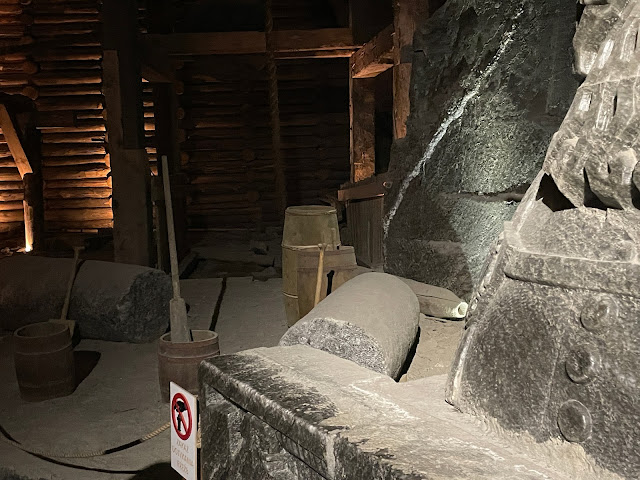 |
| The tour guide said that a column of rock salt the size shown here behind the statue would have been enough to buy a small village. |
Our next stop was the Pieskow Chamber and a series of steps downward:
Next stop was the Markowski Brothers Chamber (90m deep), named after the two of the three main sculptors - Józef and Tomasz Markowski (the third was Antoni Wyrodek). The three created the first parts of the massive Saint Kinga's Chapel that we saw later in the visit.
We saw the Paternoster - a wheel that was turned to move water between levels of the mine. When the water was fully saturated with salt it does not dissolve the walls of the mine. When the mines were flooded, the water was moved to the lower chambers where it could be safely stored as long as it was saturated (it was much cheaper than trying to move huge quantities of water to the surface.) The lowest level, level 9, is currently filled with the flood waters that had threatened the mine.
Poland was, and still is, a very religious country, and the miners were no exception. Their job was dangerous and so they used religion to give them a feeling of safety. There were many chapels that we came across in the mines, the first was the Holy Cross Chapel, built in 1860:
 |
| Carved monks which have been damaged by humidity |
 |
| Chandelier of salt crystals |
Next stop was the highlight of the tour, the St Kinga's Chapel, 101m below the surface.
Heading down the right hand staircase, the first sculpture was of St Kinga, the paton Saint of Salt Miners.
Next came the sculpture of St Barbara, patron saint of miners. The miner's uniform has 29 buttons, representing St Barbara's age when she was martyred.
At the base of the stairs was the bas-relief "Slaughter of Innocents", representing the murder of the male babies by King Herod
Above this was a nativity scene - originally made of wood, it was carved from stone by Mieczysław Kluzek.
Next is a small chapel with a sculpture of Madonna with Child. This area was originally the sacristy (the area to store the priest's vestments). The sculptures were exhibited in the Paris Exhibition (1900) and are copies of those in the Chapel of St Anthony.
The next sculpture is "Escape to Egypt", depicting the Holy Family fleeing from Herod to Egypt:
Next up was the Altar of the Heart of Jesus:
Then "The Twelve-Year-Old Christ Teaching in the Temple":
The front of the room is taken up with the main altar, including a lectern with the three coats of arms - Republic of Poland, Grand Dutchy of Lithuania and Kiev Ruthernia. It is in the shape of Wawel Castle with the dragon at the base.
The carved altar stone is a salt mensa (altar stone) with a reliquary of St John Paul II.
Behind these there is another salt mensa, this one with relics of St Kinga and the main altar, reflecting light through a statue of St Kinga. At the sides of the altar are St Joseph of Nazareth and St Clement, protector of miners.
Starting up the left wall, the first sculpture was "Marriage at Cana", where Jesus turned water into wine.
Then the Altar of the Heart of Mary:
The next bas-relief is the "Last Supper":
The Chapel of the Resurrection comes next, depicting Christ's resurrection. In one sculpture he is seen in the tomb and in another he is risen. Above him is a dove, the symbol of the Holy Spirit. The sculptor used an illusion of depth to make this alcove look much deeper than the 17cm that it is:
The final bas-relief is "Doubting Thomas":
Leading up the leftmost stairs, is another sculpture depicting a miner with a lantern. He wears an apron, the type worn by crushers. The miner depicted is the scupture Józef Markowski.
In the lower section between the stairs are three more sculptures - the first is of Our Lady of Lourdes:
The next is a monument to Pope John Paul II. He visited the mine three times and the miners often traveled to seek his blessing:
Some realistic sculptures were not part of the tour:
But behind them was the final sculpture, one showing the Legend of St Kinga and the ring in the stone.
 |
| Plaques for the main sculptors |
When we finished in the chapel we continued onward, past a pool of salt saturated water:
Our next stop was a large chamber that showed several of the types of reinforcement that were used to prop up the walls and roof. These ranged from brickwork, to wooden beams, stacked wood and anchors. To work with the anchors, a hole was drilled in the wall or roof and filled with an expanding glue - this would not only fill the hole, but also seep into the porous rock around it. A metal pole was then inserted which would bond with the glue and could be used as an anchor point:
 |
| Anchor points in the roof and walls |
Next we came to a break area with toilets and a small canteen and souvenir shop:
 |
| Statue of Johann Wolfgang van Goethe a famous German writer |
We then headed into the Weimar Chamber, for a light and sound show around a brine pool:
We then continued onward, to a statue of Jozef Pilsudski, first marshal of Poland (from 1920).
 |
| Onwards and downwards! |
Next we came to large chamber with another altar, at 130m below surface:
This then led us to the Kazanów Split-Level room where the tour ended. We were able to continue through the last few rooms at our own pace:
The first stop was Skarbnik (The Treasurer):
We then headed through a tunnel to the Wincenty Witos Chamber and then to the Witold Budryk chamber, which housed a restaurant. We had a meal 135m below surface and then continued on.
The impressive Warszawa Chamber was used for functions:
We then arrived at the Wisla Chamber and our lift out of the mine. The lift was a tight fit for us four and three other people, but it took only about 30 seconds to arrive back at the surface.
On the walk back to the car we found this, which doesn't sound as appetizing as they think it does:
From there, we started our five hour drive to our final town - Poznan.
We arrived at our apartment and even had a private underground parking garage with a reserved park. I ran inside the apartment block to get the key - we were in block C, while Kris drove around the block. I then directed her to the carpark and we parked and unloaded our bags. We missed the stair entrance because it looked like an emergency fire escape, so ended up walking around the carpark and finally found an obvious stairwell. We went up and followed the directions: Floor 2, through the glass door, number 12 on the right.
After the trouble we'd had finding our other apartments it was a relief to find this one so easily, and I said so as I fiddled with the key which wouldn't turn in the lock. The kids mused on how they were looking forward to crashing out and I continued on saying how easy the place had been to find. We had four keys on the keyring and none of them seemed to turn in the lock, so I swapped them around and tried again. Then we heard a loud banging on the inside of the door. Someone was inside and not happy that a bunch of loud Australians were trying to break into their place. We quickly retreated back to the lifts and I checked the instructions - nope it was definitely number 12 and the description and photos matched. We rode the lift back down to the ground floor and then I noticed that we were in block F. Our apartment was in block C, which looked identical, but was across the courtyard.
Hoping that no frantic Polish person was on the phone to the police reporting a roving band of Australian burglars, we found our room and settled in for the night.

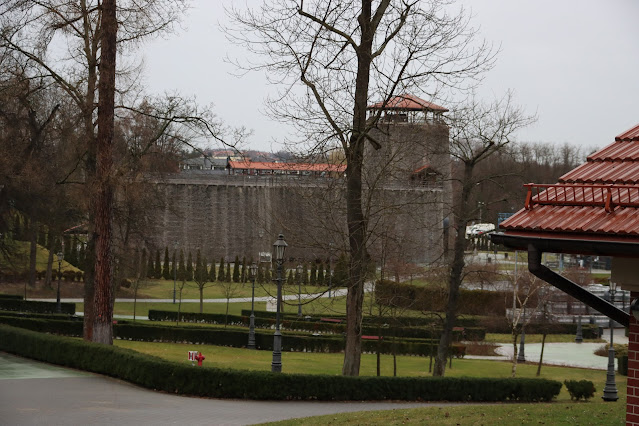






















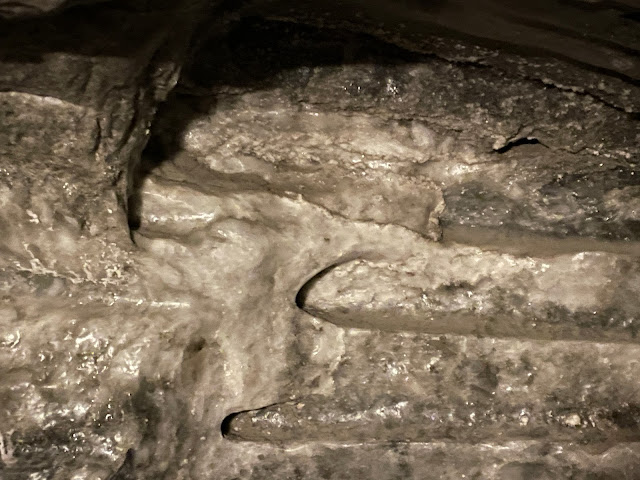











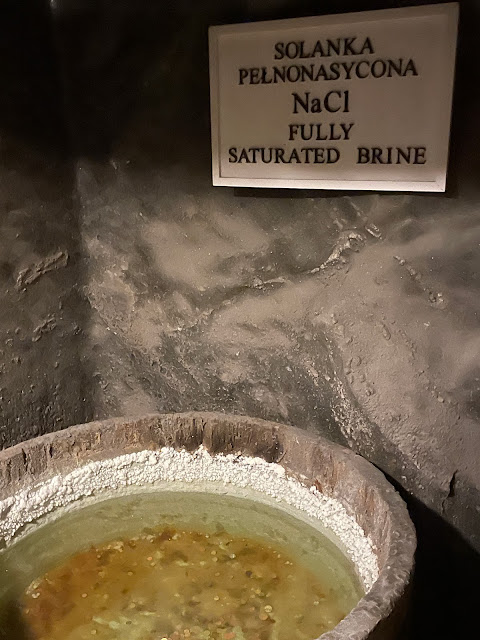

















































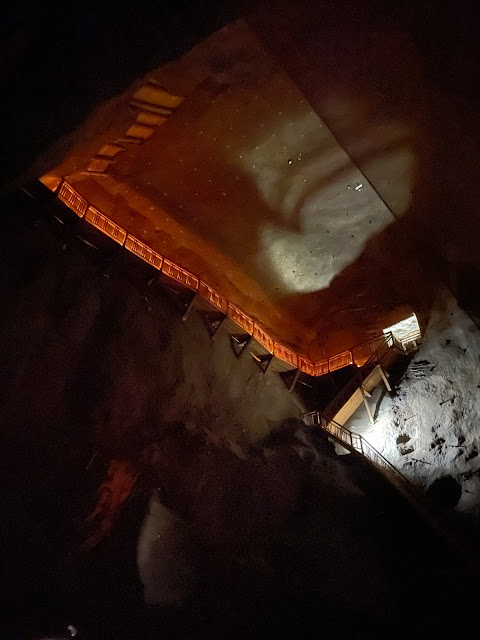
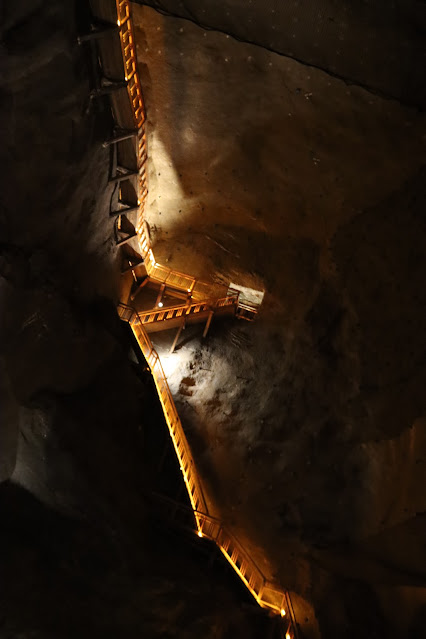











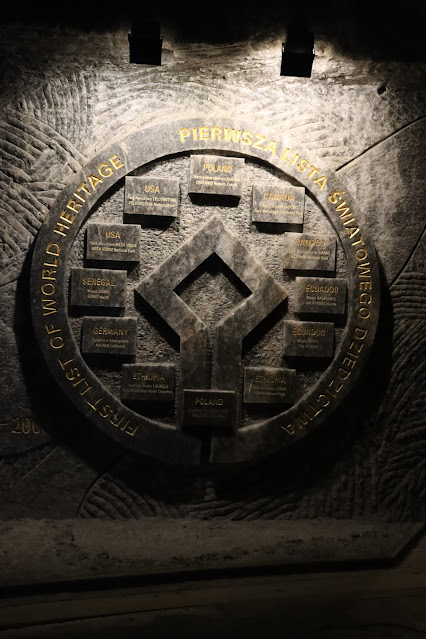







No comments:
Post a Comment